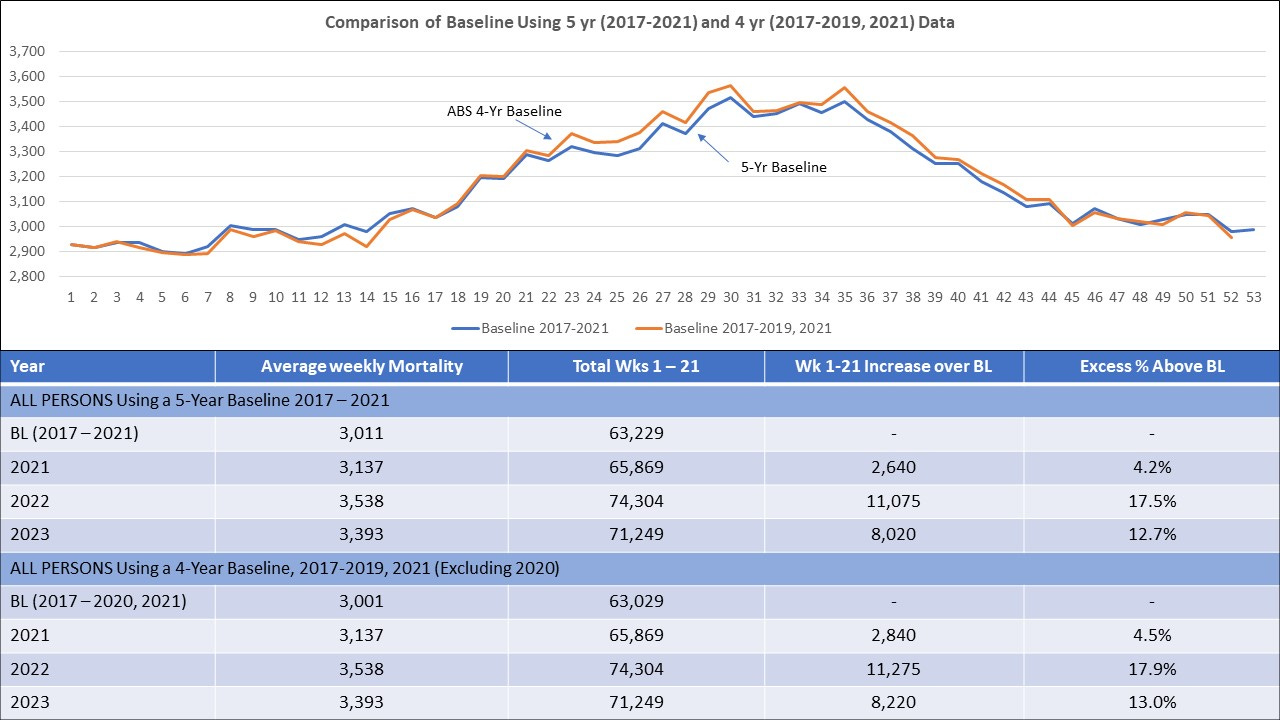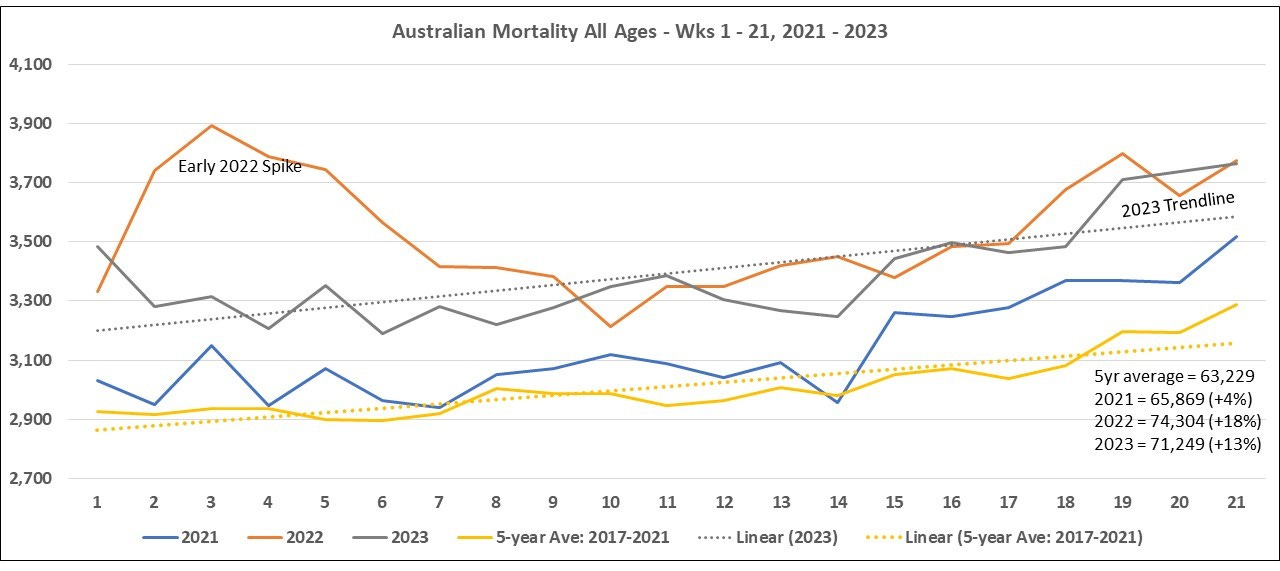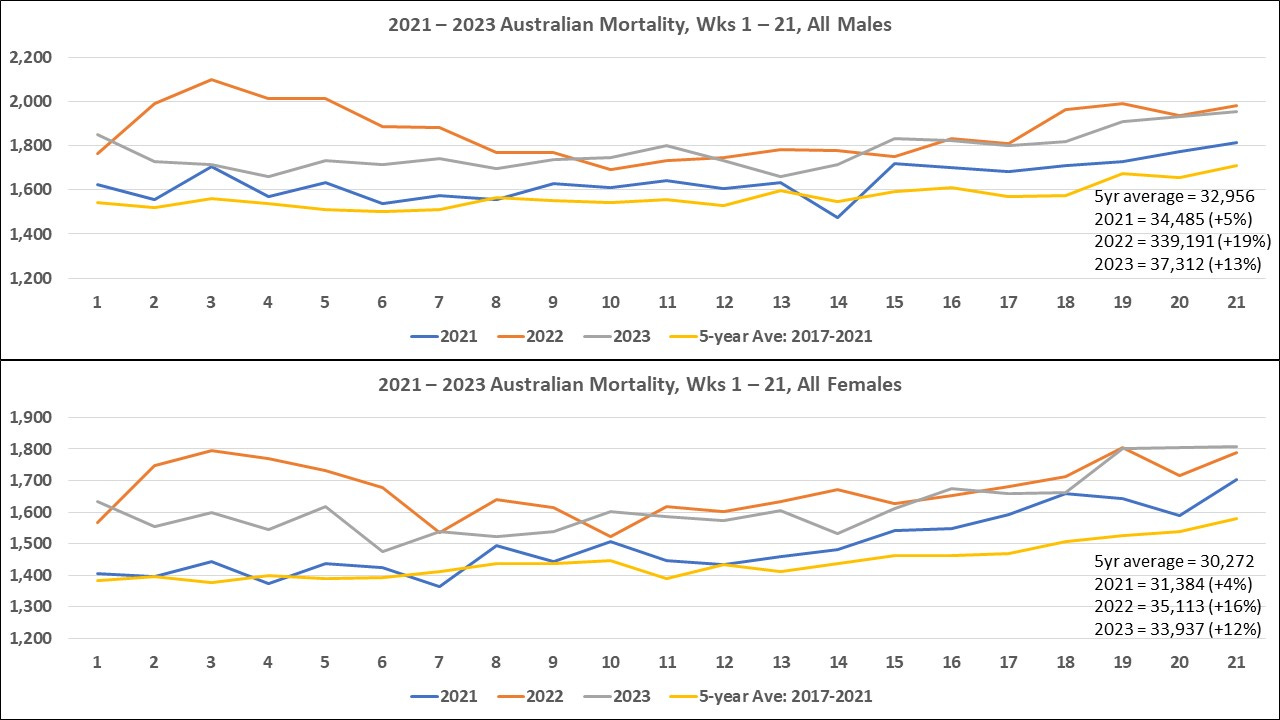Australia's Mortality Data for 2023 Weeks 1-21 Is Not Reassuring. Deaths Continue Above Baseline and are Trending Upwards as the Weeks Progress. Deaths in Women Aged 75-84 exceeded 2022 Deaths.
Only men aged 0 - 44 showed death rates below baseline for the period weeks 1 - 21. Highest excesses (+21.5%) were in folks aged 75 - 84, followed by the 85+ group (+15.3%).
Australian Bureau of Statistics has released 2023 Provisional Mortality Data for weeks 1 (starting 3rd January 2023) up to Week 21 (ending 28 May 2023). Their next detailed release will be in October 2023.
ABS chart of provisional mortality data against baseline. Deaths in 2023, though still below 2022 levels, are running at 13.2% above baseline.
Does Baseline Make A Difference?
The ABS has used a 4-year baseline from 2017 to 2021, excluding 2020. I compared baseline data for this approach as well as for a 5-year baseline from 2017 to 2021. The 4-year baseline does not make much difference to interpretation of the 2022 and 2023 deaths up to week 21; actually slightly raising the above baseline deaths (4-year BL is lower than 5-year baseline).
However, it will make a difference to effectively lower excess deaths (by giving a higher baseline by up to 1.9%) for some weeks in mid-2022, which data has not been released yet for 2023.
I plotted the 2021 - 2023 data for weeks 1 - 21 adding trendline, using the 5-year baseline. While the overall deaths for 2023 up to week 21 are lower than those in 2022, the overall trending of deaths in 2023 is increasing with the slope of the increase trend steeper than that of the baseline. This is concerning. Excess mortality is worsening as the year progresses.
I performed breakdown by gender. Males are overall faring slightly worse than females in terms of mortality above baseline (13.2% vs 12.1%).
I broke down deaths by gender and age.
Only young men (0-44) have negative excess mortality in 2023. All other age-groups have excess mortality, with the highest % excess in males aged 75 - 84. All 2023 excesses above baseline are lower than 2022 excesses. However, the trending as 2023 progresses appears to be upwards, in the later weeks rising to run close to 2022 levels.
Mortality for women also follows the same pattern as for men, with 2023 data showing generally rising trending. Younger women aged 0-44 had a 2% excess above baseline, while women aged 45-64 were 2% below baseline. A 2% change is within expected variability, though the differences between men and women in death trending may be worth noting. The most striking standout finding though is that deaths of women aged 75-84 exceed 2022 deaths by 1% and stand at 21% above baseline. Deaths in the oldest women at 12% are considerably below that of their same aged men who were at 19% excess.
Whatever is killing Australians is killing men and women at different rates. Ie. some sex-specificity.
Cause of Death Data
While Covid-19 attributed deaths were 52% lower in 2023 than the same period in 2022. They note more people died with Covid-19 than from Covid-19 as the pandemic progressed.
Large increases in degenerative and what have been considered as lifestyle causes of death are noted (as extracted below): -.
2023 Dementia and Diabetes Deaths Above Baseline but lower than 2022
2023 Dementia deaths in 2023 in January to May were 16.1% above the baseline average but 3.0% below the same period in 2022 [the age-standardised dementia death rate was 4.0/100,000 in May 2023, compared to baseline average of 3.9 and 4.1 in May 2022].
Deaths due to diabetes were 22.0% above the baseline average in May 2023, and 1.4% higher than May 2022. Diabetes deaths in 2023 in January to May were 18.7% higher than baseline average but 1.6% below the same period in 2022.
Other Cardiac, Cancer, and Respiratory Diseases Deaths above Baseline and Rising Compared to 2022
Other cardiac deaths in 2023 in January to May were 15.5% higher than baseline average and 1.0% higher than the same period in 2022 [the other cardiac age-standardised death rate was 2.4/100,000 in May 2023, compared to baseline average of 2.3 and a rate of 2.4 in May 2022].
The number of deaths due to cancer was 8.1% above the baseline average in May 2023 and 1.7% above May 2022. Cancer deaths in January to May 2023 were 7.4% above baseline average and 0.9% above the same period in 2022.
Deaths due to respiratory diseases in January to May were 4.5% above baseline average and 3.4% above the same period in 2022.
Deaths due to Ischemic Heart Disease and CVD lower than baseline
Deaths due to Ischaemic Heart Disease from January to May 2023 were 5.4% below baseline and 9.5% lower than in the same period in 2022.
Cerebrovascular disease deaths from January to May 2023 were 3.3% below baseline average and 2.3% below the same period in 2022.
Continued excess deaths in Australia with no sign of recovery or pull-forward effect (deaths should become lower than baseline when all susceptible people have died and until a new susceptible group has built up).
The cause of the excess deaths is still in effect. Of course, that is the covid-19 vaccines. The apparently upward trending of deaths in 2023 (separation from baseline trending) is very worrying. Medium and long-term effects from the genetic modification vaccines are accumulating and contributing to mortality.
This does not bode well for Australian population health.
The Government cannot afford to continue to refuse to look at this data, or to conduct a meaningful enquiry!
Help is urgently required for those who took these products, to keep them well if they are apparently unaffected, and to address health issues and extending life quality and quantity for those suffering adverse events.












Most GPs are totally unaware of this. The medical associations here don't seem to have engaged with any of the global discussion, data, analyses, legal cases. Is everyone drinking Soma in Oz?